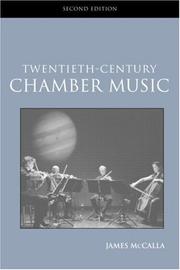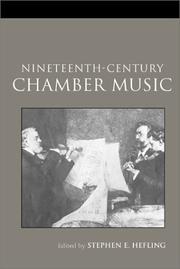| Listing 1 - 10 of 22 | << page >> |
Sort by
|
Book
ISBN: 0253056756 9780253056740 0253056748 9780253056757 025305673X 9780253056733 025305673X 9780253056733 Year: 2021 Publisher: Bloomington, Indiana : Indiana University Press,
Abstract | Keywords | Export | Availability | Bookmark
 Loading...
Loading...Choose an application
- Reference Manager
- EndNote
- RefWorks (Direct export to RefWorks)
Keyboard, string, woodwind, brass, and percussion players and teachers will find a wealth of chamber works from all periods in this invaluable guide.
Book
ISBN: 0199798931 0199700087 9780199700080 1306383196 9781306383196 9780195382532 0195382536 9780199798933 Year: 2011 Publisher: New York : Oxford University Press,
Abstract | Keywords | Export | Availability | Bookmark
 Loading...
Loading...Choose an application
- Reference Manager
- EndNote
- RefWorks (Direct export to RefWorks)
Oxford's highly successful listener's guides--The Symphony, The Concerto, and Choral Masterworks--have been widely praised for their blend of captivating biography, crystal clear musical analysis, and delightful humor. Now James Keller follows these greatly admired volumes with Chamber Music. Approaching the tradition of chamber music with knowledge and passion, Keller here serves as the often opinionated, always genial guide to 192 essential works by 56 composers, providing illuminating essays on what makes each piece distinctive and admirable. Keller spans the history of this intimate genre
Chamber music --- History and criticism. --- Analysis, appreciation.
Book
ISBN: 0252083849 Year: 2015 Publisher: Urbana Illinois ; Chicago, Illinois ; Springfield, Illinois : University of Illinois Press,
Abstract | Keywords | Export | Availability | Bookmark
 Loading...
Loading...Choose an application
- Reference Manager
- EndNote
- RefWorks (Direct export to RefWorks)
Marie Sumner Lott examines the music available to musical consumers in the 19th century, and what that music tells us about their tastes, priorities, and activities. Her social history of chamber music performance places the works of canonic composers such as Schubert, Brahms, and Dvorak in relation to lesser-known but influential peers.
Chamber music --- Chamber music --- Music publishing --- History and criticism. --- Social aspects. --- History
Book
ISBN: 9780252039225 9780252097270 0252097270 025203922X 0252083849 9780252083846 Year: 2015 Publisher: Urbana Illinois ; Chicago, Illinois ; Springfield, Illinois : University of Illinois Press,
Abstract | Keywords | Export | Availability | Bookmark
 Loading...
Loading...Choose an application
- Reference Manager
- EndNote
- RefWorks (Direct export to RefWorks)
Marie Sumner Lott examines the music available to musical consumers in the 19th century, and what that music tells us about their tastes, priorities, and activities. Her social history of chamber music performance places the works of canonic composers such as Schubert, Brahms, and Dvorak in relation to lesser-known but influential peers.
Chamber music --- Music publishing --- History and criticism. --- Social aspects. --- History
Book
Year: 1999 Publisher: New York : Mode Records,
Abstract | Keywords | Export | Availability | Bookmark
 Loading...
Loading...Choose an application
- Reference Manager
- EndNote
- RefWorks (Direct export to RefWorks)
Chamber music. --- Marimba and piano music. --- Marimba music (4 hands)

ISBN: 1135887055 0203493079 9780203493076 9780415966955 0415966957 9786610050031 6610050031 9781135887063 1135887063 9781135887018 1135887012 9781135887056 9781138171992 1138171999 0415966957 Year: 2003
Abstract | Keywords | Export | Availability | Bookmark
 Loading...
Loading...Choose an application
- Reference Manager
- EndNote
- RefWorks (Direct export to RefWorks)
This is a volume of scenes for two characters, hence duologues. The authors have selected meaty scenes from major plays, as well as from a few wonderful ones not well known. Here Jack and Algernon in The Importance of Being Earnest, Yvan and Marc in Art, Cecile and the Marquise de Merteuil in Les Liaisons Dangereuses, Mozart and Constanze in Amadeus, as well as two-character scenes from The Killing of Sister George, Kindertransport, The Crucible, and dozens of other works. Duologues provide a concentrated way of practicing skills and encourage actors to listen and respond. Helpful advice is given in the book by contributors such as Tom Stoppard, April De Angelis and Don Taylor.
Chamber music --- 525 --- Consort music --- Consorts (Music) --- Vocal chamber music --- Instrumental music --- Vocal music --- Instrumental ensembles --- Vocal ensembles --- History and criticism --- Theorie: improvisatie --- Muziekgeschiedenis (20e - 21e eeuw) --- Chamber Music --- Music

ISBN: 1135887616 1280115459 0203493087 9780203493083 9786610115457 6610115451 9781135887575 1135887578 9781135887612 9781135887629 1135887624 9781138140714 1138140716 0415966507 9780415966504 Year: 2003 Publisher: Florence : Taylor and Francis,
Abstract | Keywords | Export | Availability | Bookmark
 Loading...
Loading...Choose an application
- Reference Manager
- EndNote
- RefWorks (Direct export to RefWorks)
Chamber music -- 19th century -- History and criticism. --- Music --- kamermuziek --- muziekgeschiedenis --- anno 1800-1899 --- Chamber music --- History and criticism. --- History and criticism
Book
ISBN: 9781107534285 9781107002487 9780511751455 9781139379724 1139379720 1107002486 1107226732 1139365754 1280647388 9786613633439 1139378295 0511751451 1139375431 1139376861 1139371444 1107534283 Year: 2012 Publisher: Cambridge ; New York : Cambridge University Press,
Abstract | Keywords | Export | Availability | Bookmark
 Loading...
Loading...Choose an application
- Reference Manager
- EndNote
- RefWorks (Direct export to RefWorks)
Internationally renowned scholars and performers present a wide range of new analytical, historical and critical perspectives on some of Mozart's most popular chamber music: his sonatas with violin, keyboard trios and quartets and the quintet with wind instruments. The chapters trace a broad chronology, from the childhood works, to the Mannheim and Paris sonatas with keyboard and violin, and the mature compositions from his Vienna years. Drawing upon the most recent research, this study serves the reader, be they a performer, listener or scholar, with a collection of writings that demonstrate the composer's innovative developments to generic archetypes and which explore and assess Mozart's creative response to the opportunities afforded by new and diverse instrumental combinations. Manners of performance of this music far removed from our own are revealed, with concluding chapters considering historically informed practice and the challenges for modern performers and audiences.
Musique de chambre --- Chamber music --- History and criticism. --- Mozart, Wolfgang Amadeus, --- History and criticism --- Histoire et critique --- Consort music --- Consorts (Music) --- Vocal chamber music --- Instrumental music --- Vocal music --- Instrumental ensembles --- Vocal ensembles --- Mozart, Johann Chrysostom Wolfgang Amadeus,
Multi
ISBN: 9781107093652 9781107474666 9781316145302 1316145301 9781316533673 1316533670 9781316532713 1316532712 1107093651 1107474663 1316530558 1316531996 1316532232 131653247X Year: 2016 Publisher: Cambridge : Cambridge University Press,
Abstract | Keywords | Export | Availability | Bookmark
 Loading...
Loading...Choose an application
- Reference Manager
- EndNote
- RefWorks (Direct export to RefWorks)
In 1829 Goethe famously described the string quartet as 'a conversation among four intelligent people'. Inspired by this metaphor, Edward Klorman's study draws on a wide variety of documentary and iconographic sources to explore Mozart's chamber works as 'the music of friends'. Illuminating the meanings and historical foundations of comparisons between chamber music and social interplay, Klorman infuses the analysis of sonata form and phrase rhythm with a performer's sensibility. He develops a new analytical method called multiple agency that interprets the various players within an ensemble as participants in stylized social intercourse - characters capable of surprising, seducing, outwitting, and even deceiving one another musically. This book is accompanied by online resources that include original recordings performed by the author and other musicians, as well as video analyses that invite the reader to experience the interplay in time, as if from within the ensemble.
History of civilization --- Mozart, Wolfgang Amadeus --- Chamber music --- History and criticism. --- Mozart, Wolfgang Amadeus, --- Criticism and interpretation.
Book
Year: 2022 Publisher: Basel MDPI - Multidisciplinary Digital Publishing Institute
Abstract | Keywords | Export | Availability | Bookmark
 Loading...
Loading...Choose an application
- Reference Manager
- EndNote
- RefWorks (Direct export to RefWorks)
In recent research, there has been growing emphasis on the collaborative, social, and collective nature of musical behaviour and practices. Among the emerging hypotheses in this connection are the idea that listening to music is always listening together and being with the other; that music making is a matter of intercorporeality, mutuality, and emphatic attunement; and that creative agency in musical practices is fundamentally a distributed phenomenon. Chamber music provides an ideal context for the testing and actualization of these notions. This Special Issue on chamber music and the chamber musician aims to explore the psychological, social, cultural, historical, and artistic issues in the practice of classical chamber music in the twenty-first century. Contributions are invited on any of these aspects and issues involved in being a contemporary classical chamber musician. Authors are encouraged to contextualise their research by reference to the recent literature on collaborative musicking, and among the topics they may choose to address are the cultural and musical demands chamber musicians face and the implications of these demands for their artistic practice, the ways the twenty-first-century chamber musicians engage with historical practices, the newly emerging musical identities and artistic roles available to them, and expressivity in current chamber music practices.
artistic practice --- creative agency --- chamber music --- collaborative musicking --- distributed creativity --- expressivity in performance --- intercorporeality --- music performance --- performance practice
| Listing 1 - 10 of 22 | << page >> |
Sort by
|

 Search
Search Feedback
Feedback About UniCat
About UniCat  Help
Help News
News